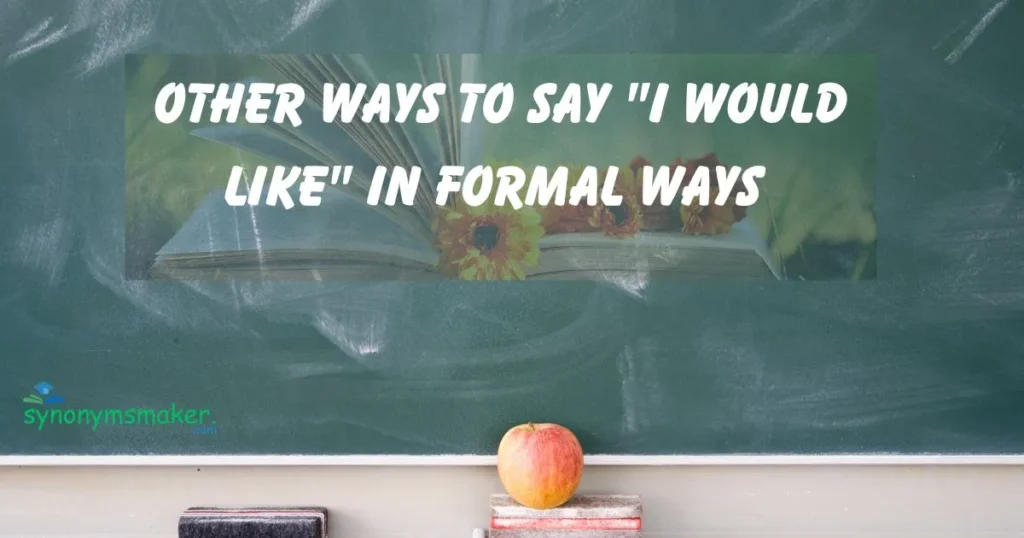Using the same phrase like “I would like” over and over can make your writing feel flat and forgettable, especially in formal settings. If you’ve ever sent an email or written a cover letter and felt like it lacked impact, you’re not alone. Choosing fresh, precise, and professional alternatives like I would appreciate, I am interested in, or May I request not only boosts your clarity but also builds your credibility.
Learn how to replace “I would like” with clear, professional phrases like I would appreciate, I am eager to, May I request, and more—perfect for emails, cover letters, and formal writing. Whether you’re saying I am eager to in an application or I am hoping to in a proposal, thoughtful word choices help you stand out and leave a lasting impression.
How to say I would like to professionally?
In formal or professional communication, instead of saying “I would like to,” you can use more refined expressions such as “I am interested in” or “I would appreciate the opportunity to.” These phrases convey a polite tone while maintaining clarity and professionalism. For example, when expressing your intention to apply for a role, you might say, “I am writing to express my interest in the position.” Similarly, if you’re hoping to participate in a project, you could use “I am seeking to contribute to the upcoming initiative.”
Other effective alternatives include “I wish to” and “I am eager to,” which both show genuine interest. If you want to sound more respectful and formal, consider “I would be grateful for the chance to” or “It would be a privilege to assist.” These add humility and sincerity to your message.
When aiming to show initiative or planning, phrases like “I intend to” and “I am keen to” are also appropriate. For requests, more polite forms such as “I respectfully request to” or “Please allow me to” can be used. If you’re offering help or taking on responsibility, “I am prepared to” or “I would be honored to” work well in formal settings.
Formal Synonyms for “I Would Like”
- I am interested in
- I am eager to
- I am hoping to
- I am inclined to
- I am seeking to
- I am looking to
- I am writing to express
- I am pleased to
- I am requesting to
- I am prepared to
- I wish to
- I intend to
- I aim to
- I desire to
- I hope to
- I would appreciate the opportunity to
- I would be honored to
- I plan to
- I respectfully request to
- I propose to
I am interested in
When you say I am interested in, it shows your genuine curiosity, strong desire, and deep willingness to learn more about a topic. This phrase is polite, positive, and helps you build better connections by showing your open mind and eagerness to explore.
Being interested in something means you pay close attention, seek deeper knowledge, and value growth. It signals you care about discovering new opportunities, enhancing your skills, and staying engaged. This phrase fits perfectly in work, studies, or everyday conversations.
Using I am interested in invites meaningful dialogue. People feel valued because you show genuine respect and motivation to listen. It builds strong trust, encourages sharing, and reflects your sincere commitment to learning and growth.
This phrase solves vague or unclear communication by clearly signaling your intentions. Instead of silence or confusion, it encourages open and honest discussions, fostering better understanding and positive relationships.
I am eager to
Saying I am eager to expresses strong enthusiasm, lively excitement, and immediate readiness to start something important. This phrase conveys positive energy, clear motivation, and shows others your passionate willingness to take action quickly and confidently.
Using I am eager to helps you stand out in interviews, meetings, or team projects. It reveals your proactive attitude, strong commitment, and readiness to contribute fully, making others trust your drive and passion.
This phrase also shares your hope and desire in a polite way. It lets others know you are looking forward to challenges or opportunities without sounding pushy or impatient, creating a respectful balance of eagerness and consideration.
Saying I am eager to helps overcome hesitation and doubt. It encourages you to express your true feelings openly, making communication more dynamic, honest, and inspiring progress in relationships or projects.
I am hoping to
When you say I am hoping to, you gently communicate your positive goals, heartfelt wishes, and realistic expectations. This phrase is soft, polite, and perfect for expressing your intentions without pressuring or demanding.
Using I am hoping to shows people you remain open to different possibilities while holding positive expectations. It conveys thoughtfulness, realism, and respect, helping build strong trust and mutual understanding.
This phrase is ideal in professional and personal settings when sharing plans or dreams respectfully. It keeps the tone calm and friendly, while showing your sincere desire to achieve or improve meaningful outcomes.
Saying I am hoping to solves the problem of sounding too strong or aggressive. It communicates your aims with gentle confidence and genuine care, maintaining polite, hopeful, and positive discussions.
I am inclined to
Saying I am inclined to reveals a natural preference, thoughtful tendency, or gentle leaning toward an option. This phrase allows you to express your opinions carefully, especially when you are still considering or undecided.
Using I am inclined to communicates your openness to alternative views while sharing your current feelings or choices. It encourages respectful, balanced discussions by showing flexibility and thoughtful reflection.
This phrase helps ease uncertainty by giving space to explore different options. It signals that you are reflective, careful, and not rushing decisions, which builds trust and invites open dialogue with others.
Saying I am inclined to solves the problem of being too firm or closed-minded. It opens a respectful way to communicate your preferences while remaining flexible and considerate of multiple possibilities.
I am seeking to
Saying I am seeking to shows clear, active effort, strong determination, and focused intention toward a specific goal. This phrase sounds formal, professional, and serious about finding solutions or new opportunities.
Using I am seeking to clarifies your focused intentions and shows you are not waiting passively but working hard with dedication and commitment. It inspires confidence in your strong drive and purposeful actions.
This phrase is highly useful in business, academic, or formal settings where clear goals and consistent effort are important. It highlights your serious dedication without sounding desperate or overly pushy.
Saying I am seeking to removes confusion about your aims and presents you as a thoughtful, driven person ready to put in consistent work to achieve meaningful and successful outcomes.
I am looking to
Saying I am looking to casually and clearly shares your current plans, honest intentions, and future desires. This phrase is friendly, approachable, and perfect for informal talks or emails when expressing what you want to do next.
Using I am looking to shows openness and honesty about your intentions. It invites others to offer helpful support, valuable advice, or constructive feedback, helping build cooperative and positive relationships.
This phrase makes communication easy, smooth, and comfortable. It signals readiness to take action soon while keeping the tone relaxed and positive, making others feel welcomed and encouraged to engage.
Saying I am looking to solves the problem of unclear or vague communication by clearly sharing your plans and inviting helpful, forward-moving conversations that benefit everyone involved.
I am writing to express
I am writing to express my deepest thoughts and important feelings clearly. This phrase helps you share your message with honesty and respect. It sets a professional yet personal tone right away.
Using this phrase shows you value the conversation and want your words to be heard carefully. It signals a purposeful communication that invites attention and understanding. This helps avoid confusion or vague intentions.
It allows your reader to know that what follows is meaningful and important. This clarity strengthens connection and trust. Saying I am writing to express solves the problem of unclear communication.
It’s a respectful way to open a conversation, especially in formal or emotional contexts. It helps you come across as thoughtful and sincere. This simple phrase enhances the impact of your message.
I am pleased to
I am pleased to share my joy and gratitude in a warm, respectful way. This phrase creates a positive tone that helps build a friendly connection with your reader. It shows genuine appreciation.
Using I am pleased to makes your communication more engaging and welcoming. It reflects a polite and professional attitude that others respect. This phrase encourages goodwill and positive interaction.
It’s perfect for sharing good news or thanking someone sincerely. It builds rapport and shows that you value the situation or relationship. This makes your message memorable and well-received.
Saying I am pleased to helps you avoid dull or cold expressions. It adds warmth and enthusiasm, making your message stand out. It solves the problem of sounding neutral or indifferent.
I am requesting to
I am requesting to ask politely and clearly for something important. This phrase is both formal and respectful, making your request easier to accept. It shows you are serious yet courteous.
Using this phrase helps balance your need with politeness. It prevents your message from sounding demanding or pushy. People are more likely to respond positively to a respectful request.
It is useful in official communication where clarity and etiquette matter. This phrase makes your intentions known without pressure. It encourages cooperation and understanding.
Saying I am requesting to solves the problem of unclear or rude requests. It makes your ask clear and respectful, increasing chances of a favorable reply. It’s a great communication tool.
I am prepared to
I am prepared to shows your readiness and confidence to take action. This phrase signals you are committed and responsible, which builds trust with your audience. It highlights your proactive mindset.
Using I am prepared to reassures others that you are serious and capable. It gives a sense of stability and readiness that encourages collaboration. This phrase reflects maturity and planning.
It’s useful when you want to express your willingness to handle challenges or tasks. It shows you are mentally and practically ready. This clear readiness can inspire confidence in others.
Saying I am prepared to solves uncertainty about your intentions. It clearly communicates you are ready to move forward. This helps prevent misunderstandings and builds respect.
Other ways to say “Don’t get me wrong”
I wish to
I wish to express my intentions in a polite and thoughtful way. This phrase shows your desire without sounding forceful or demanding. It maintains a respectful tone in formal communication.
Using I wish to clarifies your goals or needs gently. It encourages positive responses by showing consideration for others. This phrase balances assertiveness and politeness well.
It is perfect for professional or personal messages where tact matters. It communicates your purpose clearly but softly. This helps avoid misunderstandings and keeps relationships smooth.
Saying I wish to solves the problem of sounding rude or pushy. It shows respect and clarity, making your communication more effective and pleasant. It’s a reliable choice for thoughtful messaging.
I intend to
I intend to expresses your plans and goals confidently. This phrase shows you have thought carefully and are determined. It signals clear purpose and focus to your audience.
Using I intend to helps set honest expectations in a professional manner. It encourages trust by showing you are serious and organized. This phrase clarifies your future actions.
It’s useful for both casual and formal communication where clarity is key. It helps others understand your direction and prepare accordingly. This reduces confusion and builds cooperation.
Saying I intend to solves vagueness about your plans. It provides clear insight into your goals and commitment. This enhances communication and strengthens relationships.
I aim to
I aim to states your clear goals and intentions directly. This phrase shows your ambition and determination. It conveys your focus and positive attitude toward success.
Using I aim to motivates others to recognize your commitment. It communicates a purposeful drive that can inspire support. This phrase adds energy and clarity to your message.
It’s perfect for expressing objectives in both professional and casual contexts. It helps align expectations and encourages teamwork. This phrase helps prevent misunderstandings about your aims.
Saying I aim to solves the problem of unclear intentions. It presents your goals boldly and clearly. This makes your communication stronger and more inspiring.
I desire to
I desire to shares your deep personal wishes and motivations sincerely. This phrase conveys passion and heartfelt interest. It shows you care deeply about the outcome.
Using I desire to adds warmth and honesty to your message. It helps others understand your true feelings and inner drive. This makes communication more relatable and genuine.
It’s useful when expressing personal goals or emotional matters. It communicates sincerity and strong commitment. This phrase invites empathy and connection.
Saying I desire to solves the problem of weak or superficial statements. It reveals your real intentions and feelings clearly. This builds trust and engagement.
I hope to
I hope to expresses your positive expectations and gentle optimism. This phrase shows you are open-minded and polite about future possibilities. It invites goodwill and understanding.
Using I hope to keeps your tone humble and encouraging. It softens certainty and allows flexibility. This helps maintain friendly and positive communication.
It’s great for sharing plans or wishes without sounding too confident. It balances hope with respect for circumstances. This makes your message kind and approachable.
Saying I hope to solves the problem of harsh or overconfident statements. It keeps your communication hopeful and polite. This fosters better relationships and openness.
I would appreciate the opportunity to
I would appreciate the opportunity to shows polite gratitude for a chance. This phrase expresses your eagerness and respect professionally. It highlights your sincere interest.
Using this phrase makes your message humble and appreciative. It encourages goodwill and positive reception. This phrase is excellent in formal requests or job applications.
It communicates your hopes without sounding demanding. It shows you value the chance and respect the decision-makers. This builds rapport and increases positive responses.
Saying I would appreciate the opportunity to solves the problem of sounding rude or impatient. It balances respect with ambition perfectly. This makes your communication effective and polite.
Ways to say “Circling back” in an Professional Email
Real Life Examples and Scenario
Scenario 1: Requesting a Meeting with a Client
You need to politely ask a client for a meeting to discuss project updates.
Example:
I would appreciate the opportunity to schedule a meeting next week to review the progress of our ongoing collaboration and address any concerns you may have.
Scenario 2: Expressing Interest in a Job Position
You are writing a cover letter to formally express your interest in a job opening.
Example:
I am eager to contribute my skills and experience to your esteemed organization and would be honored to discuss how I can add value to your team.
Scenario 3: Asking for Additional Information from a Vendor
You want to formally request more details about a product or service from a vendor.
Example:
I respectfully request to receive further information regarding the specifications and pricing of your latest software solution.
Scenario 4: Offering to Participate in a Committee
You want to formally express your willingness to join a company committee or project group.
Example:
I am pleased to propose my participation in the sustainability committee to help advance our company’s environmental goals.
Scenario 5: Making a Formal Suggestion in a Business Meeting
During a meeting, you want to suggest a new strategy for improving customer service.
Example:
I propose to implement a customer feedback system that will allow us to better understand client needs and enhance satisfaction levels.
Conclusion
Using formal alternatives to the phrase “I would like” helps convey your messages with greater professionalism, respect, and clarity. Whether you are requesting a meeting, expressing interest, or making a suggestion, choosing the right words can make a powerful difference.
These alternatives allow you to communicate your intentions confidently while maintaining a polite and courteous tone. Mastering these expressions not only improves your writing but also builds stronger professional relationships and enhances your overall communication skills. Practice using these phrases in real-life scenarios to sound more polished and effective in formal settings.

Hi, I’m Adrian Steele, the admin of synonymsmaker.com. I’m passionate about language and dedicated to providing you with the best experience in discovering synonyms and expanding your vocabulary. Feel free to share your ideas or feedback with me. I’m always open to hearing from you!



